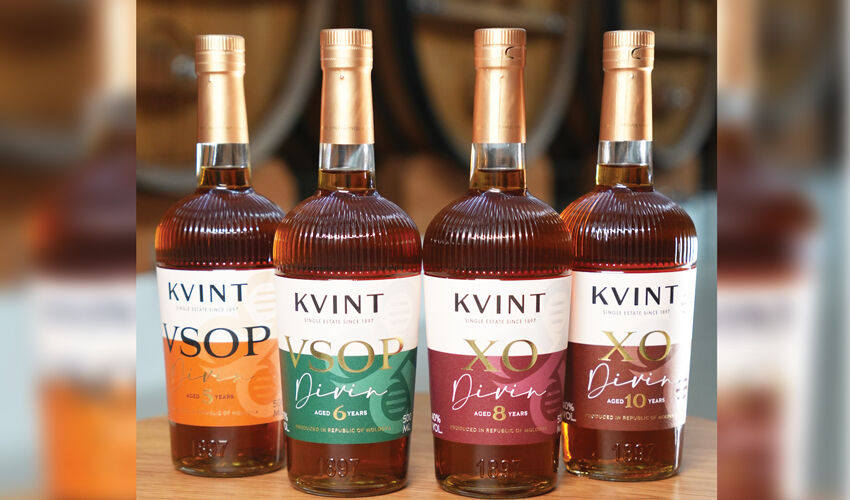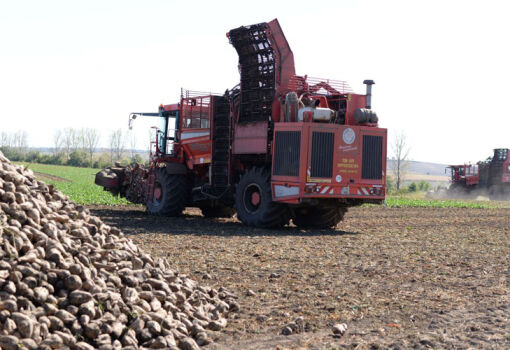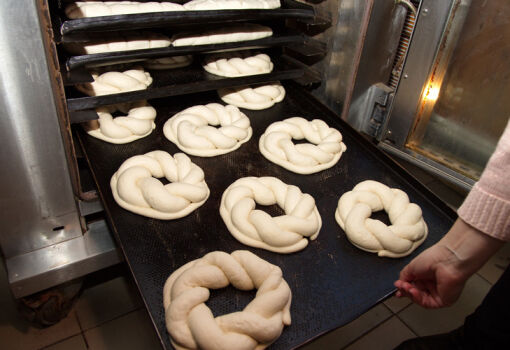
KVINT is one of the oldest domestic distillation companies whose production has been on the same historical site where it was founded for 128 years, but the current production is equipped with the most modern equipment. The company has extensive vineyard plantations and does not buy grapes on the side. Everything needed to produce high quality products is concentrated in one “estate”, so Single Estate. For Western consumers, this phrase is quite succinct in meaning. It means that the producer himself determines the requirements for grapes, grows them according to them and receives the necessary quality and quantity of bunches. And the raw material determines the quality of future wines and divines to a greater extent. And in the same company the conceived products are produced.
The new logo is at the same time simple in its design: two infinity symbols are arranged in the shape of a cross, in one of them the free space is filled with horizontal lines. And at the same time this image contains a deep meaning. The infinity symbol (horizontal eight) stands for continuity and perfection (the meaning of the old slogan has been retained), as well as cyclicality (every year the vineyard gives fruit, etc.), eternal love, harmony and infinite potential, which are carried by the art of winemaking and the creation of divines. In the curves of this symbol one can see the Dniester riverbed, on the hilly banks of which KVINT vineyards grow. The shaded circles arranged vertically remind of barrels on aging with wine or distillate. The two infinity signs stacked in this way evoke associations with both the flower – the symbol of life – and the cross – the main symbol of Christianity.
“The appearance of KVINT products should be in line with global trends, especially considering its export potential,” says Dmitrii Durnopian, Commercial Director. – Besides, the shelf of Moldovan divines looks rather homogeneous. Therefore, our task is to distinguish our products in such a way that the design elements used convey a clear enough message to consumers of different ages and from different countries. This is important for the KVINT brand to be sold in European retailers as well. The first line with rebranding elements was the classic series of KVINT divines from 5 to 10 years old, released in a new bottle”.
The bottle design is memorable for the vertical relief stripes at the top of the bottle. One can see in this the “roots” going deep into the history and traditions of the company, or endless, to the horizon, rows of vineyards where the bunches are grown for the production of these divines. And the new symbolism is reflected on the label in a discreet and stylish way.
“The divin label indicates the minimum age of the distillate from which it is made, for example, 5 years. But the blend includes distillates aged 10, 12, and 15 years in small quantities. Since we consider the spirits as a palette of colors, by means of which we create a complete picture, the profile of the divine. The proportions of distillates and their ages may change in order to maintain, year after year, the recognizable profile of each product (important for divines) to which the consumer is accustomed. We try to ensure a consistently high level of quality of our product so that the expectations of consumers are always met”, – said Natalia Toropova, Deputy General Director for Production.
According to Natalia, KVINT cognac masters adhere to a certain style in their product line. And, creating them, they select distillates so that each corresponds to the profile that was originally conceived.
Divin VSOP aged 5 years with an aroma of light floral, fruity tones, in it can be guessed a note of caramel and a light woody note.
DivinVSOP aged 6 years – for lovers of drier taste, as it is one of the driest Divins in terms of sugar content, and low sugar content releases quite different aromatic notes. The bouquet is also brighter due to the longer aging of the distillates. There are more pronounced fruity notes, tones of ageing and light resinous nuances.
Divin XO aged 8 years opens the XO group in this range (XO is Extra Old), which is noticeable in the taste, because Divin has passed the point when quantity passes into quality, namely some substances present in younger Divins in small quantities reach threshold values, i.e. we start to recognize them. This is why in an eight-year-old divine, compared to a six-year-old divine, a big leap in organoleptics is noticeable. In the bouquet, the floral note is followed by aging notes – tones of prunes, coffee, chocolate, and a nutty component. And the divine has a more beautiful, smooth, dense body.
Divin XO aged 10 years is the next step in the development of the flavor palette. There is a maturation of divin, notes of nobility appear. For divin distillates, 10 years of ageing is a definite milestone. If we compare it with human age, then there was a child, a young man, and this is already a man. At least ten-year distillates set another level of the product, you can feel the character in it. Ten-year aging gives even more depth and complexity. The aroma starts to be dominated by dried fruits, spices and noble woody tones. In the bouquet there are more dense flavors – smoked prunes, apricots, enant esters and resinous notes appear. The nutty component is involved both in the aroma and in the taste, which becomes more rounded and velvety, with a long and warming aftertaste. This Divine is for those who appreciate maturity and versatility.
“In the distance you can feel both coffee and chocolate tones, but it’s all intertwined,” continues Natalia Toropova. – You cannot single out any one prevailing note or direction of the flavor, but perceive it as a whole, studying it step by step. This indicates the high quality of the product and its naturalness – its natural origin. Because during the natural aging of distillate in oak barrels, all the substances that determine the bouquet of the future divine are formed in a complex. All notes are formed into a harmonious “portrait” of the product. A ten-year-old divin gives pleasure. It needs a little more time to unfold in order to realize the beauty of this drink, which is constantly changing over time.








